2014 Super-Middleweight Sportbike Shootout + Video

When racing organizations around the world ushered the end of the 750cc superbike era circa 2003 by allowing 1000cc four-cylinders to compete, it wasn’t long before almost every OEM dropped 750cc sportbikes from their lineups, focusing instead on developing new 1000cc beasts to comply with the revised racing rules.
Everyone except Suzuki. With its GSX-R750, Suzuki defined the modern sportbike in 1985, practically creating the superbike class along the way. With such a rich history and pedigree, Suzuki wisely stood firm in keeping the venerable godfather of sportbikes alive, surrounding it with 600cc and 1000cc siblings to comply with racing regulations.
The brilliance of that decision has now been realized, as Italy has decided to play in between the 600cc and 1000cc bookmarks. Both Ducati’s 899 Panigale and MV Agusta’s F3 800 throw racing regulations to the wind in favor of finding that balance between handling and power. We’ve long said that the GSX-R750 is the perfect 600, now it seems others are paying attention.
With that, we’ve put together the Ducati 899 Panigale, MV Agusta F3 800, and Suzuki GSX-R750 for what we’re calling the 2014 Super-Middleweight Sportbike Shootout — a test the entire MO staff has been abnormally excited to bring together. Go to Tom’s spec chart breakdown review for all the details. Here, we’re going to focus on riding impressions. In usual MO style, we rode all the bikes on the street and the racetrack in search of the best super-middleweight of them all.
2013 Kawasaki ZX-6R vs. 2012 Suzuki GSX-R750 vs. 2012 Triumph Daytona 675R
For our racetrack testing, we rode with Mickey Grana and the folks at SoCal Trackdays at Chuckwalla Valley Raceway. Incorporating a “no-sessions” format, SoCal Trackdays lets riders come on and off the track as much or as little as they want — meaning there’s no excuse for not getting enough track time. Considering the two Italians come equipped with Pirelli Diablo Rosso Corsa tires, Pirelli sent a pair of the excellent street/trackday tire for the Suzuki so we had a level playing field.
Taming Chuckwalla
Suzuki
“Old hat, comfortable shoe, hand in a velvet glove, grandpa’s old recliner… Whatever your analogy, the GSX-R750 just feels right,” says resident Ural fanboy Tom Roderick. “After a lap or so of generating tire heat you’re ready to go fast. Simple as that.”
Indeed, it is mighty easy to go fast on the Gixxer without much need to acclimate to the controls. Without any of the electronic doo-dads of the others, save for differing power modes, getting up to speed meant simply twisting the throttle. When you do, you’re met with a broad spread of usable power, all the way until its 14K rpm redline. What this means at Chuckwalla is the ability hold a gear longer, reducing the amount of shifts needed.
Power delivery is smooth and predictable with no surprises. “A very important feature,” Tom notes, “because this bike also lacks traction control, and when the rear wheel spun up a few times at full lean it was controllable and fun, but a reminder that you’re riding without that TC safety net.” And despite its smallest displacement of the trio, none of our testers found it lacking in relation to the others. So impressed with the usability of the Suzuki’s engine, it earned highest marks on the trusty MO scorecard, with Tom and E-i-C Kevin Duke rating it their favorite of the three.
Read our 2011 Suzuki GSX-R750 Review
Gripes are few, but its handling characteristics are a step behind the two Italians. Transitions can be sluggish on the Suzuki (relatively speaking, of course), though once leaned over, the fully-adjustable suspension provides ample confidence and feedback from the road. The Showa BPF fork (of which the Ducati is similarly equipped) is easy to tweak and responds well to adjustments.
“Next to the narrow Italians,” says Duke, “the Gixxer’s tank feels really wide between the knees, although it’s more of an observation than an impediment.” By no means is the 750 like straddling a Boss Hoss, but it does combine a wider seat/tank junction with narrow bars. As we’ve noted with the GSX-R line in the past, it feels like you’re sitting “in” the Suzuki rather than “on” it like the others. Adjustable pegs are also a welcome feature for track use, as the high setting keeps toes comfortably away from the hard stuff, while allowing additional legroom when set for the street.
An old school gauge cluster might seem dated now, but as Duke notes, “[the analog tachometer] is actually more effective at delivering info than the LCD displays of its Italian rivals. Bonus points for a large and easy-to-read gear-position indicator.”
After some break-in miles, the Suzuki’s monobloc Brembos (of which all three bikes have in common) worked well. Roderick noted he, “really liked the Suzuki’s Brembos.” “They’re not as fierce as the initial bite on the MV but don’t require as much lever pressure as the Panigale.”
The only one here requiring manual shifts both up and down, Duke states the obvious when he notes, “It would benefit on the track greatly by the addition of a quickshifter.” Interestingly, the ‘Zook comes with a slipper clutch — something the Duc is missing from its spec sheet. It works well, earning praise from all three testers.
MV Agusta
Moving to the MV Agusta, our impression is one of restrained optimism. We’ve bashed MV about its flawed fuel delivery in the past, but with the F3 800, progress has been made by leaps and bounds.
“Let’s give MV props for delivering ride-by-wire fuel-injection tuning that isn’t an impediment,” Duke says. “Throttle response is quick but not overly aggressive, and its throttle pickup feels mostly natural.”
The two biggest assets of the F3 800 are its lively 798cc inline-Triple and incredible handling prowess – both exhibiting Usain Bolt-like levels of quickness. Quite possibly our favorite engine configuration, the Triple delivers a healthy dose of midrange while sounding brilliant at the same time.
A glance at the dyno chart shows it and the Suzuki are virtually dead even, but short gearing and a light flywheel effect makes the F3 800 feel much more anxious. “I can’t recall another engine that picks up and drops revs so immediately to its throttle [as the MV],” Duke notes.
“The F3 transitions like nobody’s business,” says an exuberant Roderick. The shortest wheelbase in this test (54.3 inches, compared to 54.7 inches and 56.1 inches for the Suzuki and Ducati, respectively) certainly contributes to this quick-steering nature, but we believe the F3’s counter-rotating crankshaft is more than just PR fluff – it actually works.
Read our 2014 MV Agusta F3 800 Review
However, the MV is not perfect. “Its horizontal bar-graph tach is almost useless while riding at speed,” Duke notes. The gear-position indicator is also the smallest here, sometimes displaying “5” when in fact sixth was chosen. Calibration of the EAS (quickshifter to you and me), isn’t quite as quick and seamless as the Ducati, with unnecessarily long ignition kill times between gears on track.
But the biggest gripe, still, is the EFI tuning. Kevin says, “As much as I’d like to laud MV for its improved throttle tuning, the F3, like the 800 Brutale, is frustratingly difficult to carry a long wheelie due to its not-quite-predictable nature.”
Moving along, the Marzocchi and Sachs suspenders for the F3 800 respond well to adjustments. The MV exhibits confidence on its side and rewards the rider willing to push to their extremes to get the most out of the bike.
Confidence – and stamina – are what you’ll need, as the MV’s short wheelbase we love on corner entrance and transitions works against it in corner exit. Tom notes that “hard on the gas coming out of corners, the F3 800’s front wheel lifts followed by a back and forth shaking of the handlebars.” And as the only bike of the three without a steering damper, it’s on you to keep the bucking bronco under control.
Thankfully, the traction control safety net, while not as advanced as other systems on the market, means the majority of your focus can remain primarily on the front. Perhaps the F3 800’s neatest feature is its engine brake control, which allows the rider to tune the amount of engine compression braking whenever the throttle is released.
“With MV’s adjustable engine braking set to Sport you can make its four-stroke Triple behave like a two-stroke,” raves Tom. The effects are instantly noticeable, too. In its least intrusive setting, you’ll have to rely almost entirely on the brakes to scrub speed, which we tended to like.
Ducati
The Ducati 899 Panigale is an anomaly. How is it possible a V-Twin motorcycle exhibits 600cc inline-Four-like traits? The answer is the highly oversquare 898cc Superquadro engine. As expected, it pumps out the most torque in this test, but look closely at the dyno graph and you’ll notice the huge torque dip between 4500 – 7000 rpm. “It makes little logical sense that big power isn’t available until 8000 rpm,” says Kevin, “especially when its rev limit occurs just 3200 rpm later.”
As a result, the Ducati needs numerous shifts to get the most from the narrow powerband. Keep it in its sweet spot, however, and the 899 Panigale is an absolute hoot. “Once I got my shifting points mapped out, lapping the Duc around Chuckwalla was a pleasure,” Tom notes, “made more so by its sublime quickshifter.”
Another surprise is its fairly roomy cockpit, with plenty of fore-aft room, along with a slightly comfy seat and narrow seat/tank junction. Add in relatively generous legroom, and you have something we’re not used to seeing from Ducati – comfort. “For such a hardcore sportbike, the Ducati’s riding position and seat are actually fairly accommodating,” says Kevin.
The widest handlebars of the trio give the 899 Panigale tremendous leverage to flick the 437-lb. motorcycle, the heaviest here (compared to the Suzuki’s 425 lbs. and MV’s 427 lbs.) from side to side. Once banked over, all three testers favored the Ducati’s manners. Tom notes, “compared to the nervous MV, the Panigale’s sure-footedness is as reassuring to a rider navigating a technical chicane as gravity is to keeping people from drifting off the planet.” Credit some of this composure to the Ducati’s long wheelbase.
Read our 2014 Ducati 899 Panigale Review
From an electronics standpoint, the Ducati again impresses. Featuring traction control, engine brake control, and ABS, there’s no shortage of technology to help the rider lap around a track faster or safer. “The Duc takes top honors in traction control,” notes Duke, “interfering almost imperceptibly when set to DTC 2. And yet it feels very trustworthy.”
Though it lacks the super trick TFT display of its 1199 big brother, the baby Panigale again scores points for having an easy gauge cluster to read at a glance. Bright shift lights are hard to miss even at track speeds, and all the pertinent information like speed, rpm, DTC, EBC, and ABS are prominently displayed on the home screen.
Of course, the Ducati has flaws. Adjusting or otherwise manipulating the different electronic functions takes some getting used to (which owners of the bike will master very quickly), but as Roderick notes, “exiting the screen is monotonous. When I’m ready to exit the screen I’m ready to exit, don’t make me push the exit button three times.”
Also, while the Engine Brake Control is useful in theory, its application is nothing like that seen on the MV Agusta. Tom noticed “Ducati’s [EBC] system doesn’t seem to do a lot no matter what setting it’s in.”
Tom’s whining isn’t over. “Why, why, why does reducing the intrusion of both TC and ABS correspond with smaller integers, #1 being the least intrusive, while engine braking is the inverse, the least amount of engine braking corresponding to higher integers, #3 being the least amount of engine braking. WTF Ducati?”
With the track portion of our ride over, all three testers unanimously chose the Ducati 899 Panigale as their favorite. It took some testers longer than others to come to this conclusion, but in the end, we kept gravitating towards the Duc’s supreme stability and ferocious engine. However, deciding a winner on the street would prove to be a much harder decision.
Street Pretenses
Get it off the track, and the Ducati’s major flaw is obvious. “[On the street] The Duc’s lack of midrange became inexcusable,” says Roderick. “When the 150cc smaller GSX-R750 left the 899 Panigale for dead during top gear roll-ons, I was embarrassed for Ducati.”
The winner of our top gear roll-on challenge was the MV Agusta, whose short gearing and healthy midrange gave it the nudge over the Suzuki, but not by much. However, when it comes time to sludge through miles on the freeway to get to our favorite canyon roads, all three have their faults.
Both the Ducati and Suzuki have well-padded seats and moderate legroom (when the Suzuki’s pegs are at their lowest setting), but the former requires a slightly long reach to the bars and emits rear-cylinder exhaust heat to the rider’s legs and bum similar to its 1199 sibling. The latter is buzzy at freeway cruising speeds, causing hands to go numb after a while. Meanwhile, the F3 800’s seat is the least padded by far. Great for the track, not so on the street. Also, the F3’s mirrors are practically useless, as no matter how far you tuck your arms, they still block a majority of the view behind and are often blurry.
In the canyons, much of the same traits we noticed on the track transfer over. The Suzuki’s familiarity, broad powerband and stable handling means getting through the twisty stuff is done with no surprises. Its compliant suspension soaks up the road imperfections of our local SoCal streets and spits you out on the other side without any fuss. The point? The GSX-R750 is entirely capable, if not the most exciting. This practicality makes it Kevin’s choice as a street ride.
“It’s the best choice of this group if faced with a long day in the saddle,” he says. “It boasts the best wind protection, the comfiest seat and the most usable mirrors. Bonus points for its adjustable footpegs.
2014 MV Agusta Brutale 800 Dragster Review – First Ride
The Ducati, meanwhile, offers great stability, but again, the peaky engine means revs have to be much higher than expected for an 898cc V-Twin. And we have no idea how the exhaust was given the go-ahead by the sound police, either. “I love a booming V-Twin exhaust sound,” Roderick says, “but the Duc is a little loud in stock form for my taste. There’s times I prefer stealth, and the Panigale just doesn’t allow you to go unnoticed.” Duke, on the other hand, enjoyed the noise, saying it might prevent yahoos from buying louder pipes from the aftermarket.
Loud exhaust aside, the Ducati offers generous legroom, fantastic throttle response, decent mirrors, strong brakes, an easy-to-read instrument panel, and most of all, drop-dead sexy looks. Which, really, is a lot of what matters on the street. Kevin even went so far as to say the Panigale (both 899 and 1199) have the “best looking taillight in motorcycledom.” For me, good looks combined with confidence-inspiring handling make it my personal pick for the street.
The MV Agusta’s intoxicating Triple exhaust note, broad power, and extreme agility were just as fun to play with in the canyons as it was on track. Any opportunity to crack the throttle and hear those butterflies sing was welcome, and flicking the bike to and fro put a big grin on our faces. At the slower street pace, the knife edge handling we experienced on track wasn’t so bad, making it Tom’s personal favorite on the street.
“The MV’s short wheelbase, close gearing and snappy midrange power make the F3 800 a fun and exciting street bike,” he says. “When riding fast on the street and not going for lap times, the MV is my bike of choice.”
So, as you can see, our panel is undecided for an overall victor. For this test, the MO scorecard will have to decide our winner.
Results, Please!
If we’ve made anything clear so far it’s that this test was incredibly close. We wouldn’t mind having any of the three in our personal garages, but as is the case, an order has to be achieved. Here are our results, factoring both our street and track impressions, as well as objective categories like price and weight.
Third place: Suzuki GSX-R750
For $12,299, the godfather of the (now) super middleweight class represents an excellent value in the category – one that simply gets the job done. It even won three of the ten categories: Engine, Suspension, and Ergonomics – three major factors if you’re looking for one bike to do it all. It’s Duke’s pick if he were to go racing, calling it the “easy choice.”
“It’s easily the least expensive, has by far the greatest aftermarket support, and has ultimate potential to match or beat its pricier rivals around a racetrack, especially with the addition of a quickshifter and piggyback traction-control unit.”
But this test isn’t strictly about the track, and as we’ve stated before, the ‘Zook is competent, but not as exciting. Kevin again sums up the GSX-R750 thusly:
“It seems rather ordinary, but that makes it no less effective as a premium middish-sized sportbike. It can’t come close to the Italians in terms of style or electronic controls, but its ultimate capabilities are a very close match. For the money, it’s perhaps the best sportbike bargain on the market today.”
Second place: MV Agusta F3 800
The MV Agusta F3 800 is an animal. It’s hard-edged, fast, and in-your-face. It’s clear MV’s focus was on making a bike geared for the track, and in that sense the historic marque has achieved something special. In fact, if I had to pick one of these three specifically to set a fast lap time, the F3 800 would be it.
Upgrade Via Download: 2013 MV Agusta F4, F4 RR & F3
However, in the overall scheme of track and street riding, it’s perhaps a bit too much if you want one bike to do it all. It didn’t win a single category on the MO scorecard, but finished a close second many times. MV has come a long way in improving the EFI tuning, and we applaud them for that, but now it’s just missing the finishing touches. As Tom notes, “Once MV applies these new R-b-W algorithms to the other bikes in its line-up, MV will have an arsenal of arguably the best performing, as well as best looking, faired and naked sportbikes on the planet.”
At $15,798 the F3 800 is also the most expensive motorcycle in this test – but there’s always a price to pay for premium Italian motorcycles, especially one with gorgeous lines and sophisticated electronics.
Is it worth it? That’s up to you to decide, but here’s what head cheese Duke has to say, “MV Agustas have always been some of the loveliest sportbikes on the market. The F3 800 is no different in that regard, but its balance, speed and more finely tuned engine combine to make it intensely appealing.”
First place: Ducati 899 Panigale
Taking top honors in seven categories, the $14,995 ($15,295 in white, as tested) Ducati 899 Panigale emerges as our overall winner in this tightly contested battle for Super-Middleweight Sportbike supremacy. Confidence-inspiring stability, sophisticated technology, and a roaring engine make us truly feel exhilarated on the track. In fact, after spinning some laps on all three, cruiser editor, former racer, and man behind the lens, Evans Brasfield, tipped the 899 as the one that gave him the most confidence.
Of course, the top-heavy powerband of the Superquadro engine can also be a chore during normal street riding. But it’s a price we’re willing to pay, thanks in part to its slick shifter. The numbers don’t lie, and overall all three testers scored the Ducati the highest. And to think, the 899 Panigale is only “17cc smaller than the once vaunted 916 but with 20 extra horsepower,” says Kevin.
In the end, Duke sums up our thoughts, noting, “The baby Panigale is so much more than a smaller-displacement 1199. Its power is riveting when on the boil, its electronics are well sorted, and its unique Italian styling guarantees eyeballs will be paying attention.”
Check out our photo gallery for even more pictures from this shootout.
Super-Middleweight Sportbike Shootout Scorecard
| Category | Ducati 899 Panigale | MV Agusta F3 800 | Suzuki GSX-R750 |
|---|---|---|---|
| Engine | 85.83% | 88.33% | 93.33% |
| Transmission/Clutch | 96.67% | 85.00% | 85.00% |
| Handling | 90.00% | 88.33% | 85.00% |
| Brakes | 94.17% | 87.50% | 88.33% |
| Suspension | 88.33% | 88.33% | 90.83% |
| Technologies | 93.33% | 91.67% | 43.33% |
| Instruments | 90.83% | 73.33% | 83.33% |
| Ergonomics/Comfort | 85.83% | 80.00% | 90.83% |
| Appearance | 95.83% | 88.33% | 75.83% |
| Cool Factor | 93.33% | 93.33% | 66.67% |
| Grin Factor | 90.83% | 88.33% | 75.00% |
| Overall Score | 91.60% | 87.76% | 82.37% |

Troy's been riding motorcycles and writing about them since 2006, getting his start at Rider Magazine. From there, he moved to Sport Rider Magazine before finally landing at Motorcycle.com in 2011. A lifelong gearhead who didn't fully immerse himself in motorcycles until his teenage years, Troy's interests have always been in technology, performance, and going fast. Naturally, racing was the perfect avenue to combine all three. Troy has been racing nearly as long as he's been riding and has competed at the AMA national level. He's also won multiple club races throughout the country, culminating in a Utah Sport Bike Association championship in 2011. He has been invited as a guest instructor for the Yamaha Champions Riding School, and when he's not out riding, he's either wrenching on bikes or watching MotoGP.
More by Troy Siahaan





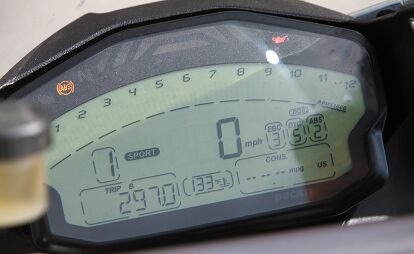

















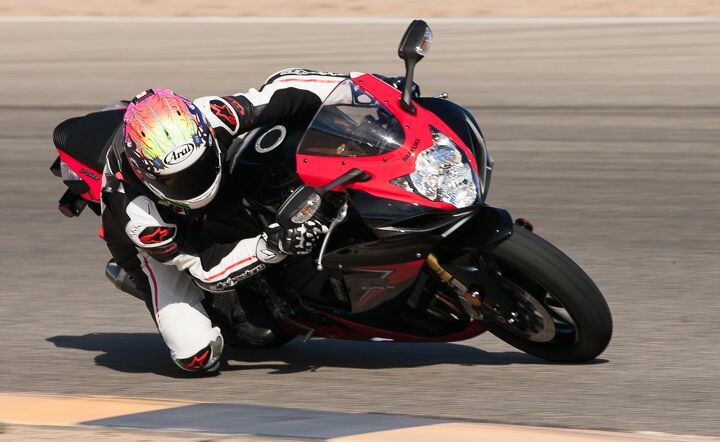

























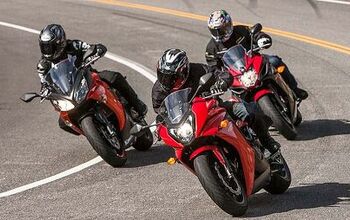
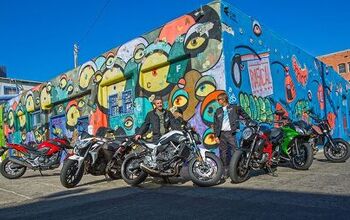



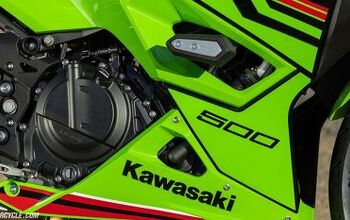








Comments
Join the conversation
Reviving something dead here... I'm just observing that the evenly weighted averaging of categories is probably not an accurate way to score a road test. I'm a Ducati guy for the record.
Out of the categories selected I would either give engine, handling, braking and ergonomics double weighting statistically (inadequacies in any of those categories are a fail for the entire bike), or I would combine cool factor and grin factor into one category and add a category for overall cohesion. A cohesion category would solve the problem of giving technology a greater weighting when it isn't a necessity in terms of performance benefit and would help to balance out statistical advantages of a bike that wins multiple performance categories that is still inferior as a complete package.
As these thoughts pertain to this review you have two expensive bikes with all kinds of "features" that have very real inadequacies winning over a bike that works well and doesn't need the features to perform at a similar level.
Personally, I might still give the win to one of the exotics - I'd rather drive a Ferrari than a Ford if the cost is as close as this test - but if a statistical approach is being used subjective judgements should have less weight; or not be included at all in the statistical portion of your breakdown. Maybe an equally weighted voting approach? each tester ranks the bikes 1,2 and 3 on which one they would most like to have and then balance that with the statistical/categorical approach?
Speaking of cost... WHERE'S THE PRICE CATEGORY!!??
As a guy who has owned 7 Ducati's and is currently on a new GSX-R750 and has had 10 other Japanese sportbikes... I would have a hard putting the Suzuki on top...
When you say, "It doesn't do anything wrong", that is not the same as saying that "it does everything the best"... Not having any glaring faults doesn't mean that it particularly shines in any one area...
I enjoy mine. It is fast, feels good and is comfortable by Sportbike standards. Would I pick it over an 899, the MV or a Daytona 675?
Yes, I did, but only based on price. I was able to scoop up a leftover '14 model, 0 miles, still in the crate and one of the 50th anniversary paint schemes, for $9,300. That's why I bought it. Am I happy with it? Hell yeah. It is a really great bike.
But if pricing was on par, I would have chosen one of the other bikes. The Euro bikes have a cool factor. How they feel, how they ride. You can feel the difference when you ride it and it is not a tangible that you can easily quantify on a chart like HP or dry weight. It's a sound and a feel. People feel the same way when they drive a Lambo or Ferrari, even if a Japanese or German car is just as fast...
The 750 that I have now, and the 2006 model that I had, are both faster than the 2007 Daytona 675 that I had. But the Triumph was by far the cooler bike to own. The sound, the way it handled, and the fact that I didn't drive past 17 of them on the way to the store.
I have ridden the 899 and 1199 and I owned both the 848 and 1198... It is a great bike, and the electronics are nice, it is fast, but to me it lacks the midrange punch that I loved about my other Ducs. The 1198 was a beast. Made the same 162hp at the wheel on my dyno that other literbikes made at the time, but the WAY it delivered it was just explosive. Just walking in first at 4000rpm and crack the throttle to 50% and it instantly wants to loop you... Rather than that build to a nice power wheelie that you see on I4 bikes. It is just THERE when you hit the gas, and you can be lazy with the shifting... forgot to downshift before the turn? Now worries... the 92ft/lbs of torque at the rear tire will effortlessly just shoot you out of the turn like it ain't no thang... haha
The Panigale is nice, but to be honest, I like the MV out of this group. Power on par with the Suziki but a strong midrange, nicer electronics package and the sheer sexiness of the bike and the exhaust note is sublime...
But that bike was $6k more than I paid for my new Suzuki. Is it cooler? Absolutely. Is it $6k cooler?
Not really. LOL